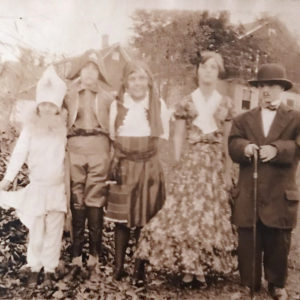Here comes Halloween! It’s a favorite celebration in this house, perhaps emanating from a love of pumpkins and apples and celebrations by dark of night. My interest in Halloween lies in its old traditions. In some places, for instance, it was known as Nutcrack Night, for it was a night for roasting nuts and using them to predict the future. Halloween has long been associated with conjuring and magic, perhaps because of its connexions with things of mystery. Its purpose as All Hallow’s Eve is to usher in the Days of the Dead that follow: All Hallows or All Saints Day on the First of November; All Souls Day on the Second. We keep the dead in mind especially at this time of year, clear through to Martinmas on November 11th.
One of the best things about Halloween, I think, is that everything is turned topsy turvy. The kids are out at night, ringing the doorbells of strangers, begging for treats. We wear costumes and masks so others don’t necessarily know our identities. And we carve lanterns out of pumpkins. How wonderful is that? That’s an old Celtic tradition, though back then and there in Ireland it was turnips that were carved. When the Irish began coming to America, pumpkins presented a great big orange glowing alternative. We’ve not gone back since.
Each year for Halloween for, oh… many many years now, I’ve written a gently ghostly story and sent it out to the world via email. It’s the Convivio Dispatch for Halloween. This year’s Halloween Dispatch will go out tonight to subscribers of the Convivio Dispatch, which is a different animal from this blog. If you’d like to make sure you receive the Halloween Dispatch, please subscribe right here. And if you’d rather get just tonight’s Halloween Dispatch without subscribing, let me know in the comments below. Leave your email address and I’ll send it. Or email me directly at mail@conviviobookworks.com to say you’d like the story. But don’t be afraid to subscribe… those particular emails from me are very few and far between, and you’ll meet an interesting cast of characters from our home town of Lake Worth.
Have a fine Halloween, filled with good spirit.
John
COME SEE US!
We’re popping up at quite a few local South Florida venues in November!
Real Mail Thursdays: Dia de Muertos Social
Thursday November 1 from 2 to 6 PM
Jaffe Center for Book Arts at Florida Atlantic University’s Wimberly Library
Boca Raton
We’ll have a mini pop-up shop of traditional handmade goods for Day of the Dead made by our artisan friends in San Miguel de Allende, Mexico.
Florida Day of the Dead Celebration
Friday November 2 from 4 to 11 PM
Downtown Fort Lauderdale
We’ll be in the Craft Crypt at Huzienga Park on East Las Olas in our own tent with a pop-up shop of traditional Mexican handicrafts for Dia de los Muertos from 4 to 7:30 PM.
Dia de los Muertos Lake Worth
Saturday November 3 from 3 to 10 PM
Hatch 1121 and Downtown Lake Worth, west of Dixie Highway
Our favorite! Find us in the courtyard at Hatch with a pop-up shop of traditional Mexican handicrafts for Dia de los Muertos, Christmas, and everyday. We’ll be there for the full length of the celebration.
Harvest Makers Marketplace
Sunday November 11 from 10 AM to 4 PM
Florida Atlantic University
Boca Raton
We’ll be transitioning toward Christmas with a pop-up shop of traditional German advent calendars and advent candles from England, plus handmade Christmas ornaments and decorations from Germany and Mexico and our full line of Shaker herbs & teas and more. Plus there’s live music all day: Rio Peterson from 10 AM to 1 PM, Ella Herrera from 1 to 4 PM. It’s going to be a good one!
Image: One of last year’s Jack O’Lanterns, on the front porch. This one is by Seth. It’s got his trademark toothless smile.


